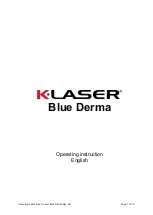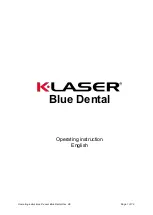
12/3/2009 | 71-022 V6
D30R
17
2
Test sequence, voltages &
applicable standards
Recommended testing sequence
In order to test motors adequately and to have effective predictive maintenance programs,
Baker Instrument Company, an SKF Group Company, suggests using a specific test sequence.
The general idea is to perform the test sequence as a series of progressively more rigorous
tests, accepting the idea that if a test fails, troubleshooting and repair should begin at that
time.
Further, more rigorous testing should only commence after satisfactory diagnosis and/or
repair
.
The suggested testing sequence is: (1)Resistance test, (2)Meg-ohm, (3)HiPot and finally (4)
Surge.
1) Coil Resistance test
A coil resistance test looks for resistance imbalance between phases, discrepancies between
measured resistance values, previous measurements and nameplate values. If a problem is
found, the motor should be inspected for the cause of the discrepancies. Typical problems
that may exist are 1) hard shorts to the motor’s core, 2) hard shorts between coils either
within the same phase or between phases, 3) coils rewound with the improper gauge wire, 4)
loose or corroded connections. Further HiPot or Surge testing is not necessary until the
resistance measurement is acceptable.
2) Megohm test
A Megohm test is performed using a test voltage based on the operating voltage of the motor
and the appropriate standards/company testing guidelines. Look for an unusually low
Megohm value when compared to previous measurements or industry accepted limits for the
type of insulation in the motor. If a low Megohm value is measured, the motor should be
inspected for ground wall insulation damage. Some part of the ground wall insulation has
failed. Possible problems include: 1) slot liner insulation or enamel wire insulation may be
burned or damaged, 2) the motor might be full of dirt, carbon dust, water or other
contaminates, 3) connections to the actual coils may be bad, 4) wrong insulation may have
been used to connect the coils to the motor’s junction box, etc. No further testing is necessary
until the reason for low meg-ohm readings
is found and corrected.
3) Principles of the Dielectric Absorption (DA) test
The Dielectric Absorption (DA) test is essentially a short-duration PI test and is usually
intended for smaller motors. Larger motors whose insulation does not easily polarize are also
good candidates for the DA test. Other than the shorter test time, all other principles are the
same as the PI test, explained in the next section.
While the PI test is recommended only for motors 200 horsepower or greater, the DA test is
useful for motors in approximately the 50 to 200 horsepower range. The DA value is the ratio
of the ground wall insulation resistance (IR) at 3 minutes to the IR value at 30 seconds.
4) Principles of the Polarization Index (PI) test
The
Polarization Index test (PI test)
is the most confusing HVDC test in use due to the
subtleties in the interpretation of the results. The PI test is performed in order to
quantitatively measure the ability of an insulator to polarize. When an insulator polarizes, the
electric dipoles distributed throughout the insulator align themselves with an applied electric
field. As the molecules polarize, a “polarization current”, also called an absorption current, is
Summary of Contents for D30R
Page 6: ...Table of Contents 12 3 2009 71 022 V6 D30R 6...
Page 12: ...Safety precautions CE compliance 12 3 2009 71 022 V6 D30R 12...
Page 24: ...Coil Resistance Testing 12 3 2009 71 022 V6 D30R 24...
Page 28: ...Principles of High Voltage DC Testing 12 3 2009 71 022 V6 D30R 28...
Page 38: ...High Voltage DC Testing 12 3 2009 71 022 V6 D30R 38...
Page 50: ...Surge Testing 12 3 2009 71 022 V6 D30R 50...
Page 70: ...Data Recording Retrieving 12 3 2009 71 022 V6 D30R 70...
















































